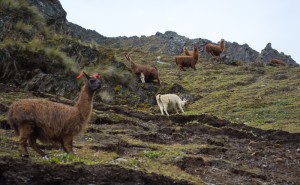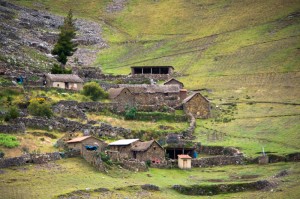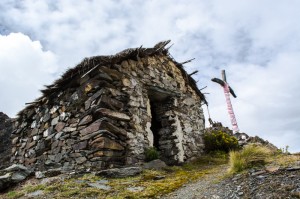Stars, Llamas, and People: The Origin of Ancasmarca

A city’s walls rise up on a hill top, above the surrounding valley. Unlike Machu Picchu, it is unrestored but looks large and dramatic.
It is called Ancasmarka, the town of Ancas, and is by the road as you rise up canyon from Calca in the sacred valley. From this location above every thing else in the valley, you can appreciate the wall of mountains that surround it and, at night the starry skies.
Above it opens a pass, an abra in Spanish or q’asa in Quechua, where you can cross over to a road that drops down into the jungles.

Below Ancasmarca you see cultivated fields making the landscape look velvety while above it graze herds of alpacas and llamas.
The Spaniard Cristobal de Molina narrated the origin of Ancasmarca around 1575 in a collection he entitled Relación de las fábulas y ritos de los Incas (account of the Fables and Rites of the Incas).

This is a very famous and important story. Molina brings it to ground in the hilltop city of Ancasmarca.
He writes the rams (male llamas) were very sad.
During the day they would not eat, and at night they were watching the stars to such a degree that the shepherd who took care of them asked them what was happening To which they [answered by] asking him to look at a group of stars that were assembled [and] there they agreed that the world was to be destroyed by water. Thus having heard this, the shepherd discussed it with his six sons and daughters , and they decided to gather as much food and livestock as they could, and [then] they climbed a very high hill called Ancasmarca. They say that as the waters rose and covered the earth, the hill grew in such a way that the [waters] never covered it. Afterward, as the waters subsided, the hill also grew smaller. Thus, from the shepherds six children who escaped [from] there, the province of these Cuyos was repopulated.

For Molina and the Spaniards this tale was proof that the Andes had experienced the great flood told in the biblical account of Noah, but to the Incas and those before them, it narrated the creation of a local people.
This tale fits with other stories of the coming of people forth from springs and lakes or caves, following the orders of the great culture hero, Wiracocha, who also went around testing the morality of people and sometimes destroying them prior to this creation.
Here the destruction was not fire from the sky as elsewhere, but an epochal flood. The llamas were sad, according to other versions, because they could understand the star’s language. From their position high in the sky the stars could see what was coming and they knew of the impending, destructive flood. People could not understand that language.
But because they paid attention to their domestic animals, their uywa, the people could perceive their sadness and, as a result, knew the future. They saved themselves by being on this high peak where the city of Ancasmarca was built.

Besides being a tale of the origin of Ancasmarca’s people, the tale evidently had a wider importance. It could be that Molina included solely because it seemed to demonstrate that Andeans were part of Biblical history. Nevertheless, he also might have included it because of the importance of this tale in the regional mythic, and ritualized history of the Incas.
In any case, Ancasmarca is a dramatic site. There is a shrine on the pass above it inside a rustic stone house as well as a cloth covered cross near it with the remains of offerings at its base. Above it people have piled stones as apachetas, prayers. The story may have been forgotten by most, but the site lives on in importance.




